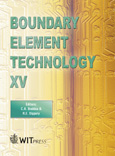Analysis Of General Time-dependent Problems With The Hybrid Boundary Element Method
Price
Free (open access)
Transaction
Volume
34
Pages
10
Published
2003
Size
500 kb
Paper DOI
10.2495/BT030061
Copyright
WIT Press
Author(s)
N. A. Dumont & R. A. P. Chaves
Abstract
Analysis of general time-dependent problems with the hybrid boundary element method N. A. Durnont, & R. A. P. Chaves Civil Engineering Department Pontijiciu Universidude do Rio de Janeiro - PUC-Rio 22453-900 Rio de Janeim, Brazil Abstract More than three decades ago, Przemieniecki [l] introduced a formulation for the free vibration analysis of bar and beam elements based on a power series of frequencies. Recently, this formulation was generalized for the analysis of the dynamic response of elastic systems submitted to arbitrary nodal loads as well as initial displacements [2]. Based on the mode-superposition method, a set of coupled, higher-order differential equations of motion is transformed into a set of uncoupled second order differential equations, which may be integrated by means of standard procedures. Motivation for this theoretical achievement is the hybrid boundary element method [3,4], as developed in [2] for time-dependent problems on the basis of a frequency-domain formulation, wh
Keywords





